Papers by nihan koseleci blanchy
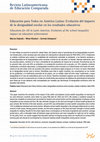
En este trabajo se examina la evolución, desde Dakar, del impacto sobre el aprendizaje de las des... more En este trabajo se examina la evolución, desde Dakar, del impacto sobre el aprendizaje de las desigualdades económi- cas intraescuela y entre escuelas para seis países de Latinoamérica utilizando datos de PISA 2000 y 2012. Empleamos un análisis multinivel para evaluar la variabilidad
del rendimiento imputable al estudiante, a los factores escolares y la heterogeneidad de las desigualdades entre escuelas a través de las escuelas y el tiempo. Además estimamos, para las escuelas pobres, cambios en el nivel e intensidad de los gradientes de riqueza de la escuela.
Encontramos que de la variación total, cerca del 40% es atribuible a la composición económica de la escuela y el 10% restante a factores individuales y escolares adicionales. La desigualdad económica entre escuelas es el determinante más fuerte del rendi- miento en las dos ondas. Entre las escuelas
más pobres, encontramos algún progreso en el nivel y la menor intensidad de la desigualdad escolar para la lectura. Resultados para toda la región muestran una convergencia en los niveles de los gradientes y el rendimiento promedio de los países, con un notable trade-off entre mejor rendimiento y mayor desigualdad en el caso de matemáticas pero no en lectura. Nuestros resultados sugieren que las políticas destinadas a aumentar el acceso a la educación por sí solas son insuficientes para alcanzar los objetivos de aprendizaje de Educación para Todos por lo que debieran estar acompañados por medidas que disminuyan la desigualdad económica entre las escuelas más pobres.
This paper examines the evolution of the impact of the within and between school wealth inequalities on learning for
six Latin American countries since Dakar by using PISA data for 2000 and 2012. We employ a multilevel analysis to
assess the variability of achievement accounted for student and school factors and the heterogeneity of between school
inequalities across schools and time. We also estimate changes on the level and strength of school wealth gradients for
poor schools. We find that of the total variation, around 40% was attributable to school wealth composition and a further
10% to additional individual and school factors. Between school wealth inequality is the strongest determinant on achievement
in both waves. Among poorest schools, we find some progress on the level and lower strength of school wealth
inequality for reading. Results for the whole region show a convergence on the levels of gradients and countries’ average
performance, with a noticeable trade-off between larger performance and more inequality for math but not for reading.
On the policy front, our results suggest that education policies increasing access alone are insufficient to achieve EFA’s
learning goal and should be accompanied by measures tackling wealth inequalities among poorer schools.
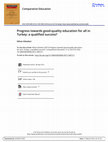
Drawing from a range of secondary data sources, this paper succinctly overviews patterns of acces... more Drawing from a range of secondary data sources, this paper succinctly overviews patterns of access to good-quality education in Turkey over the last 15 years. It also maps the policy context within which issues of access, quality and equity are examined. As a result of effective supply and demand side strategies, enrolment ratios beyond the primary level have also risen, with the average lower secondary enrolment currently standing at over 90%, and gender disparity has also been achieved at this level. Yet, educational expansion was less successful in the least developed eastern and southeastern regions of Turkey, particularly for girls. Turkey has also given a higher priority to the quality of education, in line with this global paradigm shift towards learning. However, learning levels remain low and largely unequal across regions, ethno-linguistic groups and socio-economic status. School segregation widens inequalities based on students’ socio-economic status, which should be taken into account in the aftermath of the new education reforms.
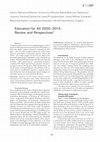
This paper provides a brief overview of global progress in achieving the six EFA goals and intern... more This paper provides a brief overview of global progress in achieving the six EFA goals and international aid for EFA policies. It shows that despite modest movement in achieving the EFA goals -some of it due to explicit policies and actions under taken by governments, international agencies, donors and NGOs -since Dakar, progress has been uneven. Much of the broad EFA agenda remains unfinished, as none of the goals was reached. The global EFA mechanisms that did work, often did so despite -rather than because of -international attempts to coordinate EFA. Much hope had been placed on external financing to accelerate EFA progress. While aid did increase, the overall volume of external assistance fell well short of the assessed need, was insufficiently targeted to countries most in need, declined as a share of recipient governments' budgets over the period, and was not always delivered effectively.
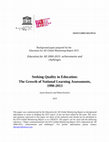
This study examines key trends and characteristics of national learning assessments (NLAs), which... more This study examines key trends and characteristics of national learning assessments (NLAs), which have been conducted with increasing frequency worldwide since the 1990s. Generally, national assessments constitute a ‘low stakes’ examination whose purpose is to evaluate student learning outcomes on the basis of criteria and expectations set by national education authorities. Unlike international assessments the results of NLAs are not comparative. This paper provides an overview of NLAs by describing the curricular subject areas and grade levels assessed, and how these have changed over time and varied across regions. In addition, it presents results from select national learning assessments to illustrate issues pertaining to changes in learning outcomes over time and ways country-level disparities in student achievement can be compared. The paper calls on international agencies, donors and civil society to consider ways to strengthen the capacities of national authorities and/or citizens to conduct, improve and, most importantly, utilize national learning assessments to ensure the provision of good quality education and effective teaching.
Recent years have seen a sustained progress in the fight against child labour. The current global... more Recent years have seen a sustained progress in the fight against child labour. The current global economic and financial crisis can potentially reverse the positive trends observed in several countries and further aggravate the problem in regions such as Sub Saharan Africa where the phenomenon of child labour has been particularly resistant to policy and programme measures. In this working paper we try to identify the main channels through which the global economic and financial crisis is likely to affect child labour and schooling decisions of households. We will briefly discuss what we know and what we would need to know better in order to design adequate mitigation policies. As underlined above, the outcomes will largely depend on policy choices; therefore it is urgent to identify the main knowledge gaps and to establish a solid monitoring system.

his study has been developed on the bases of a survey sponsored by Arab Urban Development Institu... more his study has been developed on the bases of a survey sponsored by Arab Urban Development Institute (AUDI). However, a report that assesses the quality of the survey (such as the validity of assumptions underlying capture and recapture methodology), the problems encountered and how they were dealt with is not yet available. At the time of preparing this report, the labels of the data set were only partially translated in English, so some important information (such as region of origin) cannot be presented here. The remainder of the report is organized as follows. Section two briefly reviews the national context, and specifically major socio-economic factors underlying the problem of street children problem in the country. Section three briefly presents the methodology adopted to study the profile of street children on the streets of Cairo. Section four examines the characteristics of street children. Section five then turns to the schooling of these children. Section six looks at living and work conditions of street children in the sample. Finally, section seven reviews the reasons why children live away from their families.
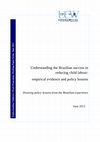
Brazil has witnessed dramatic progress towards eliminating child labour and achieving universal b... more Brazil has witnessed dramatic progress towards eliminating child labour and achieving universal basic school enrolment in the last two decades. Indeed, in the period from 1992 to 2009, economic activity among 7-15 year-olds fell by more than half, from 18 percent to less than seven percent, while school attendance rose from 85 percent to 97 percent. What were the factors underlying this success? Was it driven primarily by policy? And, if so, which policies were most influential? Or, alternatively, was the progress more a product of demographic trends, or of broader changes in the Brazilian macro-economy and labour market? The current report takes up these questions using data from the multi-year Pesquisa Nacional por Amostra de Domicilios (PNAD) survey programme. It looks in detail at trends in child labour and schooling over the 1992-2008 period, and analyses the reasons behind these trends, in an attempt to draw concrete policy lessons from the Brazilian experience applicable in countries lagging behind in terms of child labour elimination efforts.
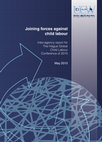
Much has evolved in terms of our knowledge surrounding the child labour problem and
eff ective st... more Much has evolved in terms of our knowledge surrounding the child labour problem and
eff ective strategies for addressing it since the last major conferences on child labour which were
held in Amsterdam and Oslo in 1997. Th is report makes use of advances in research achieved
through UCW and other eff orts to take stock of the global child labour situation, assess key
remaining obstacles to the elimination of child labour and identify strategies for addressing
them. The report presents evidence of country-specifi c child labour situations and trends, of
reasons why child labour matters from a child rights and national development perspective,
and of the policies holding greatest potential for combating it in the period leading up to the
2016 target date set by the Global Action Plan, endorsed by the ILO, to eliminate the worst
forms of child labour. It also identifi es areas where information gaps constitute an impediment
to policy formulation. The report highlights the close linkages between child labour and broader development
objectives, and the consequent need to address child labour as an important component of national
development strategies. It also illustrates the wide array of factors contributing to child
labour, and the resulting importance of a broad, integrated policy response to it. Finally, the
report underscores the importance of concerted action by international development agencies
in support of Government eff orts in the fi ght against child labour. International development
agencies have a support role to play both in the development of integrated national strategies
against child labour, and in the implementation of such strategies, in accordance with the
relative strengths of each agency.
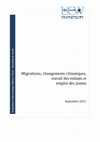
Ce rapport UCW a été produit dans le cadre d’un programme de recherche sur la migration lancé par... more Ce rapport UCW a été produit dans le cadre d’un programme de recherche sur la migration lancé par la Banque mondiale. Ce programme vise notam-ment à focaliser l’attention des décideurs sur les effets de la migration interne sur les enfants et les jeunes. Le rapport examine d’une part les changements climatiques et leur rapports avec les flux de migration interne, et d’autre part, la manière dont ces changements affectent la situation sociale des enfants et des jeunes. L’étude a été menée dans les limites imposées par la carence de données dans ce domaine. En effet, l’information statistique relative à la mi-gration interne est relativement ancienne, et, suite à des discussions menées avec l’agence sénégalaise de la statistique, il a été arrêté que les travaux se-raient basés sur des données primaires de l’année de référence 2002. L’étude n’en est pas moins la première à produire un tableau détaillé de l’état de la migration interne et de son impact, dans le contexte spécifique du Sénégal. Elle rassemble de nombreuses informations sur les vastes et divers flux mi-gratoires manifestes au Sénégal, et sur les vulnérabilités sociales propres aux enfants et aux jeunes qui migrent. Elle fait apparaître la nécessité d’une poli-tique de migration cohérente, et qui se préoccupe des populations concer-nées, y compris les enfants et les jeunes. Elle souligne également la nécessité de recueillir une information suffisante sur l’impact de la migration, qui serait le fondement d’une telle politique. L’augmentation inévitable des flux migra-toires à venir, impulsés par les changements climatiques, ne fait qu’accentuer le caractère impératif d’une réponse politique adaptée.
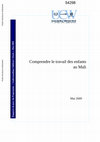
La présente étude, qui s’inscrit dans le cadre du Programme UCW au Mali, a pour but de fournir, d... more La présente étude, qui s’inscrit dans le cadre du Programme UCW au Mali, a pour but de fournir, d’une part, une vue d’ensemble du phénomène (son ampleur, ses caractéristiques, ses répercussions sur la santé et sur l’éducation des enfants) et,
d’autre part, un panorama des efforts entrepris au niveau national pour le maîtriser.
Notre travail répond à quatre grands objectifs du projet UCW dans le pays : (i)
approfondir la compréhension du phénomène du travail des enfants et par là,
appuyer la mise en oeuvre de politiques et de programmes adéquats, (ii)
promouvoir le débat politique sur le travail des enfants en tant que facteur de
vulnérabilité sociale, (iii) analyser les relations entre abandon scolaire précoce,
travail des enfants et performances futures sur le marché du travail et (iv)
participer à l’établissement d’une capacité nationale de recherche, de collecte et
d’analyse des données relatives au travail des enfants et à l’emploi des jeunes.
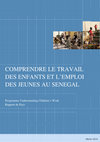
La présente étude, qui s’inscrit dans le cadre du Programme UCW au Sénégal, a pour but de fournir... more La présente étude, qui s’inscrit dans le cadre du Programme UCW au Sénégal, a pour but de fournir, d’une part, une vue d’ensemble du phénomène (son ampleur, ses caractéristiques, ses répercussions sur la santé et sur l’éducation des enfants) et, d’autre part, un panorama des efforts entrepris au niveau national pour le maîtriser. Notre travail répond à quatre grands objectifs du projet UCW dans le pays : (i) approfondir la compréhension du phénomène du travail des enfants et par là, appuyer la mise en oeuvre de politiques et de programmes adéquats ; (ii) promouvoir le débat politique sur le travail des enfants en tant que facteur de vulnérabilité sociale; (iii) analyser l’interdépendance des relations entre abandon scolaire précoce, travail des enfants et performances futures sur le marché du travail et (iv) participer à l’établissement d’une capacité nationale de recherche, de collecte et d’analyse des données relatives au travail des enfants et à l’emploi des jeunes.
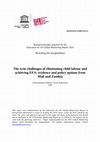
Child labour constitutes a key obstacle to achieving Education For All (EFA) and Millennium Devel... more Child labour constitutes a key obstacle to achieving Education For All (EFA) and Millennium Development Goals in Mali and Zambia. It not only arms the welfare of individual children, but also slows broader national poverty reduction and development efforts. Children forced out of school and into labour to help their families make ends meet are denied the opportunity to acquire the knowledge and skills needed for gainful future employment, thereby perpetuating the cycle of poverty. One out of every two Malian and Zambian children aged 7-14 years work regularly in economic activity, underscoring the scale of the challenge posed by child labour in the two countries. Understanding the interplay between educational marginalisation and child labour is critical to achieving both EFA and child labour elimination goals. Prepared as a background paper for 2010 Education for All Global Monitoring Report on 'Reaching the Marginalized', this paper forms part of UCW broader efforts towards improving this understanding of education-child labour links, making use of recent empirical evidence from Mali and Zambia.
The study looks at differences by sex in key dimensions of the child labour phenomenon in Banglad... more The study looks at differences by sex in key dimensions of the child labour phenomenon in Bangladesh and India – its extent, nature, and effect on education outcomes. It addresses what type of activity is more common among girls, and the extent to which girls’ work experience differs from that of boys.The study encompasses not only girls and boys at work in economic activity, but also those performing household chores in their own homes. The latter group of children, dominated by girls, is frequently overlooked in child labour statistics and in analyses of child labour. This can result in gender biases both in the understanding of child labour and in policies addressing it.
L’objet du présent rapport est de préciser le profil et la situation des enfants qui mendient dan... more L’objet du présent rapport est de préciser le profil et la situation des enfants qui mendient dans la région de Dakar. Le rapport a pour point de départ une enquête menée auprès des enfants mendiant dans les rues de Dakar, laquelle a fourni un premier état des lieux, assorti d’une vue d’ensemble des actions entreprises à l’échelle nationale, face à ce problème. L’enquête a également permis de proposer diverses options stratégiques visant à accélérer et renforcer la réponse nationale contre la mendicité enfantine. Finalement, il convient de souligner que même si cette étude prétend donner une image assez représentative de la situation des enfants mendiants dans la zone de Dakar, elle ne dépeint pas la condition de l’ensemble des enfants talibés vivant dans les daaras.










Uploads
Papers by nihan koseleci blanchy
del rendimiento imputable al estudiante, a los factores escolares y la heterogeneidad de las desigualdades entre escuelas a través de las escuelas y el tiempo. Además estimamos, para las escuelas pobres, cambios en el nivel e intensidad de los gradientes de riqueza de la escuela.
Encontramos que de la variación total, cerca del 40% es atribuible a la composición económica de la escuela y el 10% restante a factores individuales y escolares adicionales. La desigualdad económica entre escuelas es el determinante más fuerte del rendi- miento en las dos ondas. Entre las escuelas
más pobres, encontramos algún progreso en el nivel y la menor intensidad de la desigualdad escolar para la lectura. Resultados para toda la región muestran una convergencia en los niveles de los gradientes y el rendimiento promedio de los países, con un notable trade-off entre mejor rendimiento y mayor desigualdad en el caso de matemáticas pero no en lectura. Nuestros resultados sugieren que las políticas destinadas a aumentar el acceso a la educación por sí solas son insuficientes para alcanzar los objetivos de aprendizaje de Educación para Todos por lo que debieran estar acompañados por medidas que disminuyan la desigualdad económica entre las escuelas más pobres.
This paper examines the evolution of the impact of the within and between school wealth inequalities on learning for
six Latin American countries since Dakar by using PISA data for 2000 and 2012. We employ a multilevel analysis to
assess the variability of achievement accounted for student and school factors and the heterogeneity of between school
inequalities across schools and time. We also estimate changes on the level and strength of school wealth gradients for
poor schools. We find that of the total variation, around 40% was attributable to school wealth composition and a further
10% to additional individual and school factors. Between school wealth inequality is the strongest determinant on achievement
in both waves. Among poorest schools, we find some progress on the level and lower strength of school wealth
inequality for reading. Results for the whole region show a convergence on the levels of gradients and countries’ average
performance, with a noticeable trade-off between larger performance and more inequality for math but not for reading.
On the policy front, our results suggest that education policies increasing access alone are insufficient to achieve EFA’s
learning goal and should be accompanied by measures tackling wealth inequalities among poorer schools.
eff ective strategies for addressing it since the last major conferences on child labour which were
held in Amsterdam and Oslo in 1997. Th is report makes use of advances in research achieved
through UCW and other eff orts to take stock of the global child labour situation, assess key
remaining obstacles to the elimination of child labour and identify strategies for addressing
them. The report presents evidence of country-specifi c child labour situations and trends, of
reasons why child labour matters from a child rights and national development perspective,
and of the policies holding greatest potential for combating it in the period leading up to the
2016 target date set by the Global Action Plan, endorsed by the ILO, to eliminate the worst
forms of child labour. It also identifi es areas where information gaps constitute an impediment
to policy formulation. The report highlights the close linkages between child labour and broader development
objectives, and the consequent need to address child labour as an important component of national
development strategies. It also illustrates the wide array of factors contributing to child
labour, and the resulting importance of a broad, integrated policy response to it. Finally, the
report underscores the importance of concerted action by international development agencies
in support of Government eff orts in the fi ght against child labour. International development
agencies have a support role to play both in the development of integrated national strategies
against child labour, and in the implementation of such strategies, in accordance with the
relative strengths of each agency.
d’autre part, un panorama des efforts entrepris au niveau national pour le maîtriser.
Notre travail répond à quatre grands objectifs du projet UCW dans le pays : (i)
approfondir la compréhension du phénomène du travail des enfants et par là,
appuyer la mise en oeuvre de politiques et de programmes adéquats, (ii)
promouvoir le débat politique sur le travail des enfants en tant que facteur de
vulnérabilité sociale, (iii) analyser les relations entre abandon scolaire précoce,
travail des enfants et performances futures sur le marché du travail et (iv)
participer à l’établissement d’une capacité nationale de recherche, de collecte et
d’analyse des données relatives au travail des enfants et à l’emploi des jeunes.
del rendimiento imputable al estudiante, a los factores escolares y la heterogeneidad de las desigualdades entre escuelas a través de las escuelas y el tiempo. Además estimamos, para las escuelas pobres, cambios en el nivel e intensidad de los gradientes de riqueza de la escuela.
Encontramos que de la variación total, cerca del 40% es atribuible a la composición económica de la escuela y el 10% restante a factores individuales y escolares adicionales. La desigualdad económica entre escuelas es el determinante más fuerte del rendi- miento en las dos ondas. Entre las escuelas
más pobres, encontramos algún progreso en el nivel y la menor intensidad de la desigualdad escolar para la lectura. Resultados para toda la región muestran una convergencia en los niveles de los gradientes y el rendimiento promedio de los países, con un notable trade-off entre mejor rendimiento y mayor desigualdad en el caso de matemáticas pero no en lectura. Nuestros resultados sugieren que las políticas destinadas a aumentar el acceso a la educación por sí solas son insuficientes para alcanzar los objetivos de aprendizaje de Educación para Todos por lo que debieran estar acompañados por medidas que disminuyan la desigualdad económica entre las escuelas más pobres.
This paper examines the evolution of the impact of the within and between school wealth inequalities on learning for
six Latin American countries since Dakar by using PISA data for 2000 and 2012. We employ a multilevel analysis to
assess the variability of achievement accounted for student and school factors and the heterogeneity of between school
inequalities across schools and time. We also estimate changes on the level and strength of school wealth gradients for
poor schools. We find that of the total variation, around 40% was attributable to school wealth composition and a further
10% to additional individual and school factors. Between school wealth inequality is the strongest determinant on achievement
in both waves. Among poorest schools, we find some progress on the level and lower strength of school wealth
inequality for reading. Results for the whole region show a convergence on the levels of gradients and countries’ average
performance, with a noticeable trade-off between larger performance and more inequality for math but not for reading.
On the policy front, our results suggest that education policies increasing access alone are insufficient to achieve EFA’s
learning goal and should be accompanied by measures tackling wealth inequalities among poorer schools.
eff ective strategies for addressing it since the last major conferences on child labour which were
held in Amsterdam and Oslo in 1997. Th is report makes use of advances in research achieved
through UCW and other eff orts to take stock of the global child labour situation, assess key
remaining obstacles to the elimination of child labour and identify strategies for addressing
them. The report presents evidence of country-specifi c child labour situations and trends, of
reasons why child labour matters from a child rights and national development perspective,
and of the policies holding greatest potential for combating it in the period leading up to the
2016 target date set by the Global Action Plan, endorsed by the ILO, to eliminate the worst
forms of child labour. It also identifi es areas where information gaps constitute an impediment
to policy formulation. The report highlights the close linkages between child labour and broader development
objectives, and the consequent need to address child labour as an important component of national
development strategies. It also illustrates the wide array of factors contributing to child
labour, and the resulting importance of a broad, integrated policy response to it. Finally, the
report underscores the importance of concerted action by international development agencies
in support of Government eff orts in the fi ght against child labour. International development
agencies have a support role to play both in the development of integrated national strategies
against child labour, and in the implementation of such strategies, in accordance with the
relative strengths of each agency.
d’autre part, un panorama des efforts entrepris au niveau national pour le maîtriser.
Notre travail répond à quatre grands objectifs du projet UCW dans le pays : (i)
approfondir la compréhension du phénomène du travail des enfants et par là,
appuyer la mise en oeuvre de politiques et de programmes adéquats, (ii)
promouvoir le débat politique sur le travail des enfants en tant que facteur de
vulnérabilité sociale, (iii) analyser les relations entre abandon scolaire précoce,
travail des enfants et performances futures sur le marché du travail et (iv)
participer à l’établissement d’une capacité nationale de recherche, de collecte et
d’analyse des données relatives au travail des enfants et à l’emploi des jeunes.